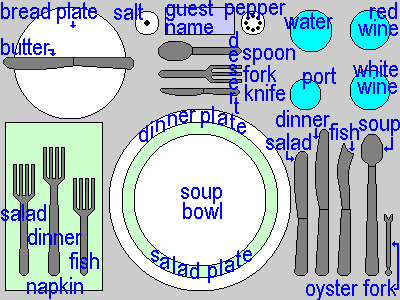Typical Formal Dinner Table Layout

The picture illustrates a typical place setting used for a formal dinner. The colours are only intended to aid identification because most venues present white crockery, gold/silver/stainless cutlery and clear glasses. Depending on the menu, some items will not be required and would not be present on the table or will be removed after you select your meal.
If you are about to attend your first formal meal, you may find some of the following comments interesting. This is a very basic introduction and should not be regarded as an accurate guide.
- Read your invitation before attending. This will usually indicate an acceptable dress code. Watch out for the phrase "black tie," or "white tie." These have specific dress-code meanings (which can easily be found on other web-sites.) Guests should confirm (or decline) their attendance at a formal dinner quickly and there will normally be a contact number on the invitation. The phrases "and Guest" or "Plus-One" may indicate that you can bring a partner, however, each "expected" guest may receive a separate invitation.
- On arrival, you may be directed to a foyer/bar area while awaiting an invitation for all guests to enter the hall and take their seats
- Look out for a seating plan in the foyer/bar. This is often located near to the dining area doors. The plan will indicate the layout of the dining hall and at which table you will be seated.
- When the dining area doors open, hold back a few seconds. This will avoid any embaressment should the event or venue have a tradition of certain guests leading the way.
- On arrival at your seat, check the place card to ensure you have the correct table. It may not be polite to sit down immediately, a quick glance at other guests should reveal the correct time to be seated.
- It is normal for tuxedo jackets to remain on until the MC invites removal.
- Don't worry about the large amount of crockery and glasses, their purpose may become obvious when the waiting staff serve each part of your meal.
- When selecting cutlery, the general rule is the first required items will be on extreme left and right of your place setting. Then work slowly inwards. The items behind your plate will be used for dessert etc. When in doubt, a glance around your table should reveal a fast eater using the correct impliment.
- Formal dinners are often served as a large number of "courses." A course is a part of the meal served separately. Early Formal course portions may appear small relative to informal events but some Dinners will have in excess of 10 courses!
- Most "casual" British catering establishments present food that caters for "British" expectations, nobility could regard their food as very hot and over-cooked. A Formal Dinner would normally serve food prepared to "international" expectations. An inexperienced British formal diner could easily confuse "correctly prepared" with "luke warm" and "under-cooked."
- If drinking wine, leave a small amount in the bottom of your glass. Venue staff could interpret an empty glass as a request to refil. A tradition known as "toasting" is quite common which often takes place at the end of your meal. Everyone is invited to take a tiny sip of their drink to acknowledge the queen, honoured guest or special event. The waiting staff sometimes offer all guests a small glass of port, (or similar,) to ensure that everyone has a drink for toasting. (If toasts are likely to be problematic, most venues are able to supply a non-alcoholic alternative for your glass.)
- Allergen Warning - if you suffer from a food allergy, it may be prudent to check the menu with the venue/host staff prior to accepting an invitation. The large number of courses could result in you encountering a problematic product. As an example, the final "food" course sometimes includes nuts.
www.DigitalDan.co.uk